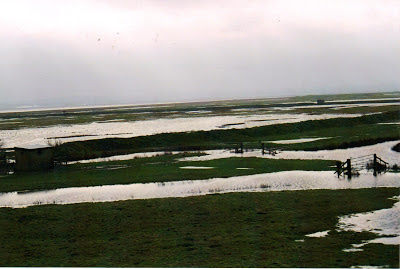Wednesday, 19 December 2012
A Year of Extremes
The flooding on the reserve continues to increase by the week and with another series of rainy days forecast for the next week, things look like getting worse. We haven't quite reached the levels seen in the photos above, taken around five years ago, but it's a fair bet that early into the New Year we will have done.
Obviously it makes fantastic and attractive habitat for all manner of wildfowl and wading birds and indeed, they become spoilt for choice so to speak, but it makes it bloody difficult, indeed depressing, trying to find a way round the reserve without wearing chest waders. Unless we get a very dry March, which often happens, conditions look set to stay awkward until at least April, which seems an awful long way away!
Looking back through the year, it's certainly been one of extremes as far as conditions have been concerned. We began 2012 in the middle of a winter drought and despite a few days of snow cover, it remained dry until the end of the winter. Indeed, by the end of March all the ditches, fleets and rills on the reserve were either dry or containing just a few inches of water and it did not bode well for the breeding season that was just beginning. However, as we now know, things changed dramatically during April and we quickly went from one extreme to the other, during April and May it not only stayed cold but it got wetter and wetter. The water courses quickly re-filled to their normal levels but more importantly, as the vegetation began to grow it stayed both wet and cold for long periods of time and with little sun to dry and warm them, the chicks of ground-nesting birds began to succumb to the cold. Birds such as Lapwings, Redshanks and even Skylarks, struggled to keep their chicks not only dry and warm but supplied with the few insects that there were about. Three pairs of Marsh Harriers nesting in rape nearby all saw their chicks succumb as the weight of the wet foliage saw the plants collapse over the nests, making access difficult.
Eventually our counts for The Swale NNR showed just 26 breeding pairs of Lapwings (a 42% drop on 2011) and only c. 4 chicks fledged. Redshanks also fledged very few chicks and even our resident pair of Barn Owls had their chicks die while still in the nest, presumably due to the parents finding it difficult to hunt for food in constantly wet vegetation.
It was quite frankly a disaster of a breeding season all round, borne out as we went into June, by suggestions that it was the wettest summer on record. That for me, was also a bit of an extreme statement, or it was where Sheppey was concerned, because as June progressed into July and August and we did eventually get some warm and dry weather, the reserve began to quickly dry out again. It certainly wasn't the kind of blistering weather that I would of liked but the reserve continued to dry out and lo and behold, by September we were back to near drought conditions - quite incredible, no water, no wildfowl and few waders! The continuing statements in the papers of how it had been the wettest summer on record all seemed a bit daft as we looked at parched rills and low ditch levels again.
And now, just to complete this year's mad merry-go-round of weather extremes, we are approaching flood levels again across the reserve, could we possibly fit in sweltering temperatures in the two weeks that are left - I somehow doubt that.
Subscribe to:
Post Comments (Atom)


It was very sad to read one of your earlier reports about the loss of the Barn Owl young on your patch Derek. I think one of the adults there was the only Barn Owl I saw carrying food back from my own viewing patch to young all year. But to no avail.
ReplyDeleteThere are reasonable numbers of Barn Owls around where I watch on Sheppey, just got to hope they all get/keep mates and survive the winter.
The loss of Harrier young you mention also stikes a chord with me. It was great watching a male catching food to take to a rape seed nesting site for a week or two. Upsetting when suddenly that all ended before the young could have fledged. I think!
Cheers,
Bryan
Bryan,
ReplyDeleteOne of our pair of Barn Owls died in the early part of last winter but fortunately a mate had arrived before the breeding season began. This year was the second running the young have not survived, last year three young were rung and fledged but all were found dead near the nest site within a week of leaving the nest.
Likewise, harriers did very poorly all over Harty this year, presumably due to the weather.
It certainly has been a topsy turvey year as far as the weather goes. Let's hope next year will have better fortunes for the breeding birds. All the best, have a great Christmas.
ReplyDeleteCheers Alan, you too.
ReplyDeleteA long, hot summer will do me.